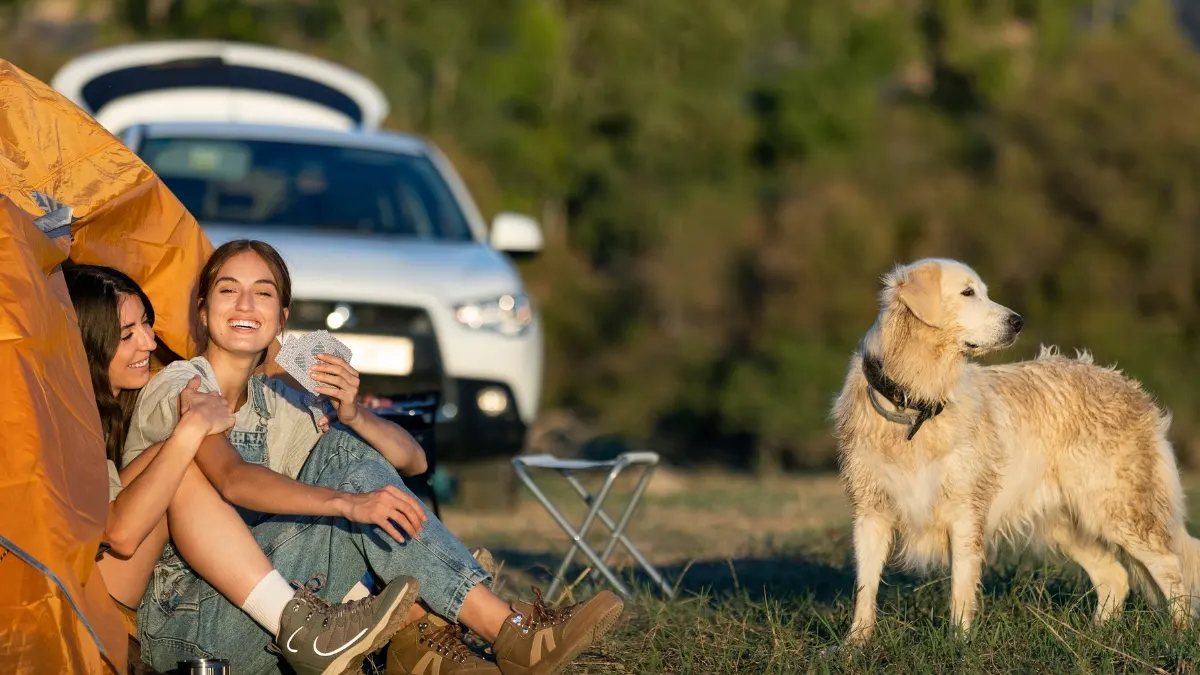The dream is simple: the open road, a new horizon, and your best friend panting happily in the passenger seat. But the reality of RV traveling with a dog involves a lot more than just packing their favorite toy.
You’re worried about the unknowns. What if they bark constantly? What if they overheat? Are all “dog-friendly” campgrounds really friendly? The anxiety can overshadow the excitement.
This isn’t just another list of tips for RVing with dogs. This is the hard-earned wisdom from veteran RVers. These are the 19 things they all say they wish they had known before their first trip. This guide gives you a specific plan to keep your dog safe, happy, and well-behaved on the road in 2025.
The “Paperwork” Phase: 4 Planning Tips You Can’t Ignore
Imagine pulling into a campground after an 8-hour drive, only to be turned away at the gate. This happens every day. These four planning steps will make sure it doesn’t happen to you.
1. “Dog-Friendly” Has Fine Print

“Dog-friendly” just means “dogs are allowed.” It doesn’t mean “dogs are welcomed.” You’ll find that many dog friendly RV parks still ban pets from common areas. Always read the specific pet policy before you book.
- “Dog-friendly” often means dogs are restricted only to your specific campsite.
- Most parks (like KOA or Thousand Trails) will not allow dogs in pools, clubhouses, playgrounds, or restaurants.
- Some parks have designated “dog run” areas, but many do not.
2. Breed Restrictions Are Real (and Non-Negotiable)

This is a trip-ender. Many park insurance policies ban “aggressive” breeds. This isn’t up for debate at the check-in counter. Even if your dog is a perfect angel, the rule is the rule.
For example, Timber Ridge RV Park in Texas clearly forbids “Pit Bulls, Chows, Mastiffs, Dobermans, Rottweilers, German Shepherds, Wolf-mixes, or Malamutes.”
- Action: Always call the park’s front desk and verbally confirm your dog’s breed is allowed. Do not trust the website alone.
3. You Need a Vet “Go-Bag” (Digital & Physical)

You need your dog’s papers ready. Many parks require proof of rabies vaccination just to check in. If you have an emergency on the road, you won’t have time to call your vet back home.
Create two versions of this kit:
- Digital: A folder in Google Drive or on your phone with photos of each document.
- Physical: A waterproof binder.
Your Go-Bag Must Include:
Happy Tails: Pet Travel Pack
4. Your Microchip Info is Dangerously Outdated

This is a tip most people forget. Your dog’s microchip is probably linked to your home phone number. That phone is in your empty house. This is useless on the road.
- Your Action: Before you leave, log in to the microchip company’s website (like HomeAgain or Avid).
- Critical: Change the primary contact number to your cell phone number.
- Add a secondary contact, like a friend or family member who knows you’re traveling.
The “Gear” Phase: 4 Packing Tips Beyond Food and a Leash
Now that your binder is prepped, let’s talk about the physical prep. Your dog has no idea what an RV is. Your first job is to teach them it’s a happy place.
5. You Need a “Practice Run” in the Driveway

An RV is a big, scary, noisy box. You must get your dog used to it slowly. The experts at Go Pet Friendly call this “positive association.” It teaches them the sounds are normal.
Calm Canine: RV Training
Engine Off Exposure
For a few days, sit in the parked RV (engine off) with your dog. Give treats and praise.
Engine On Introduction
Once calm, turn on the engine for a few minutes. Give more treats. Then turn it off and get out.
Noisy Operations
Operate slide-outs & jacks while they’re inside. It will be loud! Feed high-value treats the entire time.
6. A “Splash-Guard” Water Bowl is Non-Negotiable

A regular water bowl will spill 100% of the time. The first time you hit the brakes or take a sharp turn, you’ll have a puddle. Water + RV flooring = swelling and damage. You need a travel bowl designed for this. Look for “splash-guard” or “no-spill” options like those from LumoLeaf or Kurgo.
7. You Need a “Command Center” by the Door

This is a simple trick that saves your sanity. Put a small bin or a few command hooks right by the RV door. This is your “Command Center.” It stops the “Where is the…?” panic every time you need to go out.
It Must Hold:
- Your leash (on its own hook).
- A roll of poop bags.
- A dedicated “mud towel” or “paw rag” for wiping feet.
- A small jar of high-value treats (for rewarding good behavior when coming and going).
8. Pack for Rainy Day Boredom

A wet, bored dog in a 30-foot box is a recipe for disaster. They will get destructive. You must pack items specifically for these moments. The key is to only bring these items out on rainy days so they stay special.
Boredom-Buster Kit:
- Lick mats (smear with peanut butter and freeze it to make it last).
- Puzzle toys (like a Kong Wobbler or a Nina Ottosson puzzle).
- Long-lasting, safe chews (like bully sticks or beef tendons).
On the Road: 4 “Must-Knows” for Safe Driving
This section on RV dog safety is not optional. For your dog and for you, the drive itself is the most dangerous part of the trip.
9. A Loose Dog in an RV is a Projectile

This is the hard truth. An unsecured 60-pound dog in a 50-mph crash becomes a 2,700-pound projectile. They can be killed, and they can kill you. You would never let a child ride unsecured, and the same rule must apply to your dog.
10. CRITICAL: The Motorhome vs. Travel Trailer Rule

This is the most critical driving tip for RV traveling with a dog.
- In a Motorhome (Class A, B, C): Your dog can be secured in the living area.
- In a Towable (Travel Trailer or 5th Wheel): Your dog MUST ride with you in your tow vehicle (the truck).
It is incredibly dangerous and illegal in many states to leave them in a moving trailer.
- There is no climate control.
- The motion is violent and will cause panic.
- There is no crash safety.
Critical Alert
NO CLIMATE CONTROL
System Failure. Risk of extreme heat or cold.
VIOLENT MOTION
Unsecured environment. Will cause panic.
NO CRASH SAFETY
Zero passenger protection systems detected.
11. Not All Harnesses Are Safe. You Need a Certified One

Most “car harnesses” you find online are not crash-tested. They will break. The Center for Pet Safety (CPS) is an independent group that tests these products.
- What to Look For: A harness that is certified by the Center for Pet Safety.
- 2025 Certified Brands: The Sleepypod Clickit Sport and Sleepypod Clickit Terrain are top-rated, certified products.
- What to Avoid: Do not use a simple dog seatbelt clip that attaches to their walking collar. This can cause neck or throat injuries in a stop.
12. “Quick” Potty Breaks Don’t Exist

New RV drivers are always in a rush. You can’t be. A “5-minute” stop at a rest area will take 20 minutes with a dog. They have been cooped up and stressed by the road noise. Budget this extra time into your travel day.
When you stop, your dog needs time to:
- De-stress from the road vibrations.
- Stretch their legs.
- Sniff all the new smells (this is mental exercise).
- Actually go to the bathroom (which they may be too nervous to do right away).
At the Campground: 4 Rules of “Good Neighbor” Etiquette
Welcome to the campground. The first rule of being in dog friendly RV parks is simple: Your dog’s freedom ends where your neighbor’s campsite begins.
13. The 6-Foot Leash Rule is Universal (and for Your Dog’s Safety)

Every park has this rule. Good Sam, KOA, and state parks all require dogs to be on a 6-foot leash. This isn’t just to protect others; it’s to protect your dog.
This rule exists because:
- Your “friendly” off-leash dog might run up to a reactive leashed dog.
- It keeps your dog from running after a child or a squirrel.
- It stops them from walking through another person’s campsite.
14. Your Dog Will Bark at Everything

Your dog is on high alert. The new sounds are everywhere: neighbors’ doors, golf carts, squirrels. They will bark. Your job is to manage it. Never leave a barking dog alone in your RV.
A simple plan:
- The second they bark, get up.
- Calmly go to the window and “look” at what they see.
- Say a firm, clear command like “Quiet” or “Thank you.”
- The moment they are silent, reward them with a high-value treat.
15. You Can’t Leave Them Unattended Outside (At All)

This is a top rule at almost every park, including Thousand Trails. It means you cannot tie your dog to the picnic table and go for a walk. It also means you cannot leave them in a portable “X-Pen” or fence.
Why this rule is smart:
- Theft: A friendly, purebred dog is a target.
- Wildlife: Coyotes, raccoons, and other animals can injure an unattended dog.
- Escape: A scared or determined dog can easily get out of a pen.
16. A Pet Gate Inside the Screen Door Prevents Escapes

This is a brilliant, simple tip from the Go Pet Friendly blog. Buy a standard, pressure-mounted baby gate. Place it inside your RV, a few inches behind the screen door.
This simple gate does three jobs at once:
- It prevents your dog from bolting out the second you open the door.
- It stops them from scratching or jumping on your fragile screen door.
- It creates a small “mudroom” where you can take off shoes before the dog greets you.
Inside the RV: 3 “Wish I Knew” Tips for Daily Life
We’ve saved the most critical, life-saving tips for last. This is the core of RV dog safety in 2025.
17. An RV Heats Up Faster Than a Car

This is the #1 life-saving tip. An RV is a greenhouse with huge windows. It heats up faster than a car. The National Weather Service and ASPCA show that even on a mild 75°F day, the temperature inside a vehicle can hit 100°F in just 10 minutes.
An RV’s A/C can fail in several ways:
- The campground power cuts out (a common “brown out”).
- Your air conditioner unit simply breaks.
- Your generator runs out of fuel.
18. You Must Have a Cellular Remote Temperature Monitor

This is the non-negotiable solution. It’s the only way to leave your pet with peace of mind.
- Cellular (The Right Choice): Brands like Waggle and MarCELL run on their own 4G/5G cellular signal. If your power cuts out, they still work and will send a text alert to your phone.
- Wi-Fi (The Wrong Choice): Do not buy a Wi-Fi or Bluetooth monitor. Campground Wi-Fi is terrible and unreliable. The second it fails, your monitor is useless.
A cellular monitor is the best investment you can make for your dog’s safety.
19. You Have to “Teach” Them Their “Place”

In a 200-square-foot space, a dog is always underfoot. You will trip over them. To keep everyone safe and sane, you must teach them a “place” command.
Bring their actual bed from home (as the KOA blog suggests) so it smells familiar. Use high-value treats to heavily reward them for going to their bed and staying there.
Use this command when you are:

